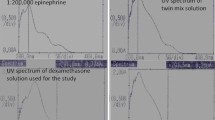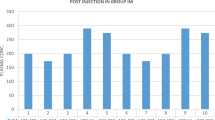Abstract
Introduction
There is convincing evidence supporting the addition of dexamethasone to lignocaine and its administration as an intra-space injection to achieve benefit of a single dose steroid after third molar surgery. This study was undertaken to validate the existing data on the use of twin mix in minor oral surgery based on power analysis, statistical sample size estimation and an ultraviolet (UV) spectrometry study for chemical stability of the mixture.
Material and methods
A prospective, randomized, double-blind trial was designed to validate the pilot study on the efficacy of twin mix and 2 % lignocaine with 1:200,000 epinephrine in the surgical removal of impacted mandibular third molars. Clinical parameters of anaesthetic latency, anaesthetic duration, efficacy of twin mix as an anaesthetic and post-operative patient discomfort were assessed. The stability of active ingredients in the solution was assessed using a double beam UV-visible spectrophotometery.
Results
The results of the study showed better post-operative outcome with administration of dexamethasone and lignocaine as an intra-space injection in decreasing the post-operative patient discomfort. The anaesthetic efficacy of the twin-mix admixture was found statistically similar to the control solution of 2 % lignocaine with 1:200,000 epinephrine. The λmax recorded for dexamethasone and local anaesthetic individually was obtained with the twin-mix solution, which indicated no change in the active pharmacological compounds.
Discussion
Clinical anaesthetic efficacy of twin mix is comparable to 2 % lignocaine with 1:200,000 epinephrine when administered in the pterygomandibular space with the additional advantage of a single prick co-administration of dexamethasone with local anaesthetic, lesser sting of the local anaesthetic injection, shorter anaesthetic latency, prolonged duration of the soft tissue anaesthesia and decrease in post-operative discomfort after the oral surgical procedure.




Similar content being viewed by others
References
Bhargava D, Sreekumar K, Rastogi S, Deshpande A, Chakravorty N (2013) A prospective randomized double-blind study to assess the latency and efficacy of twin-mix and 2 % lignocaine with 1:200,000 epinephrine in surgical removal of impacted mandibular third molars: a pilot study. Oral Maxillofac Surg 17(4):275–280
Bhargava D, Sreekumar K, Deshpande A (2013) Effects of intra-space injection of twin mix versus intraoral-submucosal, intramuscular, intravenous and per-oral administration of dexamethasone on post-operative sequelae after mandibular impacted third molar surgery: a preliminary clinical comparative study. Oral Maxillofac Surg. doi:10.1007/s10006-013-0412-7
Movafegh A, Razazian M, Hajimaohamadi F, Meysamie A (2006) Dexamethasone added to lidocaine prolongs axillary brachial plexus blockade. Anesth Analg 102(1):263–267
Biradar PA, Kaimar P, Gopalakrishna K (2013) Effect of dexamethasone added to lidocaine in supraclavicular brachial plexus block: a prospective, randomised, double-blind study. Indian J Anaesth 57(2):180–184
Grossi GB, Maiorana C, Garramone RA, Borgonovo A, Beretta M, Farronato D, Santoro F (2007) Effect of submucosal injection of dexamethasone on postoperative discomfort after third molar surgery: a prospective study. J Oral Maxillofac Surg 65(11):2218–2226
Majid OW (2011) Submucosal dexamethasone injection improves quality of life measures after third molar surgery: a comparative study. J Oral Maxillofac Surg 69(9):2289–2297
Majid OW, Mahmood WK (2011) Effect of submucosal and intramuscular dexamethasone on postoperative sequelae after third molar surgery: comparative study. Br J Oral Maxillofac Surg 49(8):647–652
Klongnoi B, Kaewpradub P, Boonsiriseth K, Wongsirichat N (2012) Effect of single dose preoperative intramuscular dexamethasone injection on lower impacted third molar surgery. Int J Oral Maxillofac Surg 41(3):376–379
Esen E, Taşar F, Akhan O (1999) Determination of the anti-inflammatory effects of methylprednisolone on the sequelae of third molar surgery. J Oral Maxillofac Surg 57(10):1201–1206
Arufe-Martinez MI, Romero-Palanco JL, Gamero-Lucas J, Vizcaya-Rojas MA (1989) The application of derivative spectrophotometry for the simultaneous determination of cocaine and other local anesthetics. J Anal Toxicol 13(6):337–353
Tiwana PS, Foy SP, Shugars DA, Marciani RD, Conrad SM, Phillips C et al (2005) The impact of intravenous corticosteroids with third molar surgery in patients at high risk for delayed health-related quality of life and clinical recovery. J Oral Maxillofac Surg 63:55–62
Conflict of interest
Nil
Funding
Nil
Author information
Authors and Affiliations
Corresponding author
Rights and permissions
About this article
Cite this article
Bhargava, D., Deshpande, A., Khare, P. et al. Validation of data on the use of twin mix in minor oral surgery: comparative evaluation of efficacy of twin mix versus 2 % lignocaine with 1:200000 epinephrine based on power analysis and an UV spectrometry study for chemical stability of the mixture. Oral Maxillofac Surg 19, 37–41 (2015). https://doi.org/10.1007/s10006-014-0446-5
Received:
Accepted:
Published:
Issue Date:
DOI: https://doi.org/10.1007/s10006-014-0446-5




